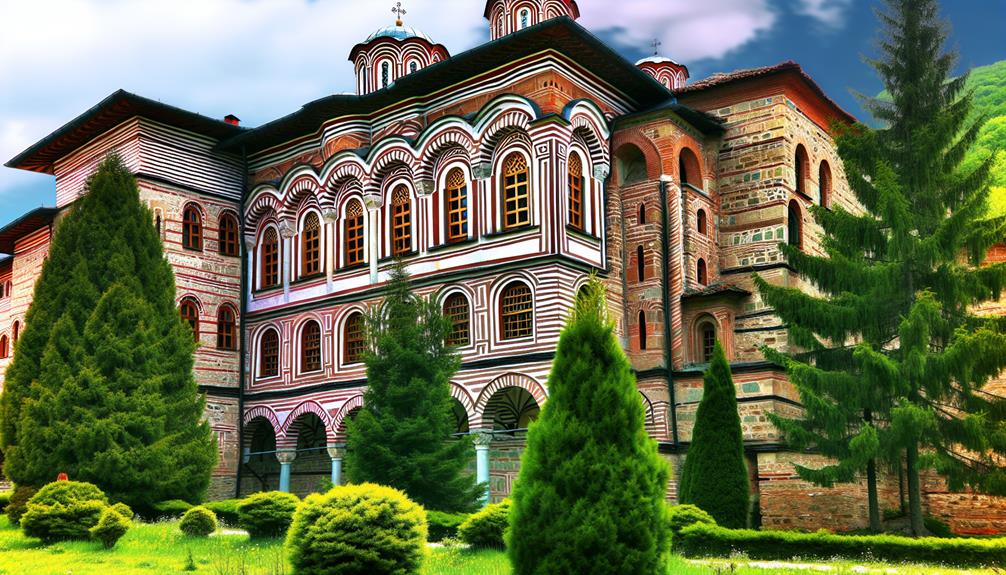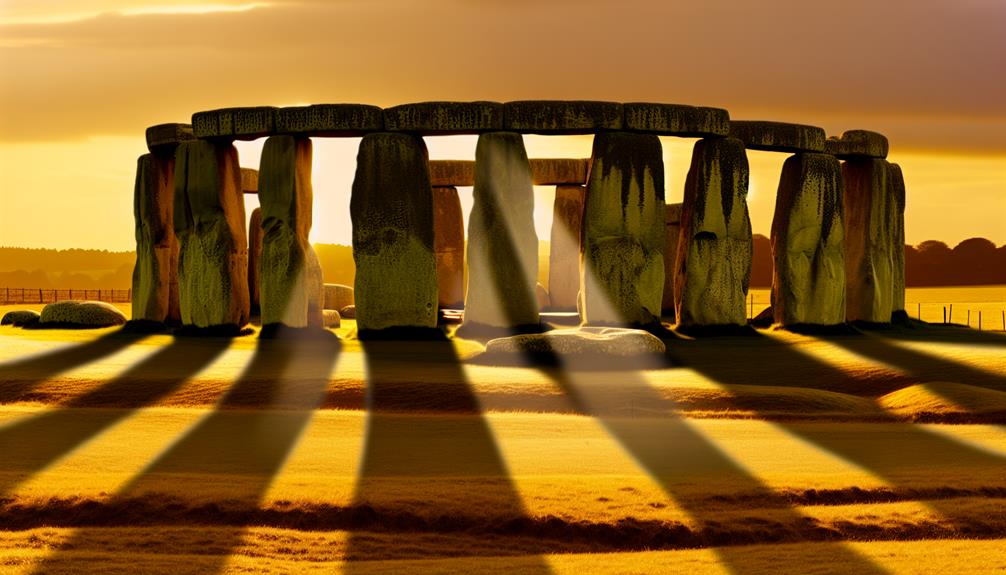Nestled in the serene Rila Mountains of Bulgaria, the Rila Monastery stands as a testament to centuries of history and cultural significance. With its blend of architectural styles and iconic frescoes, this Eastern Orthodox monastery offers a glimpse into a world of spiritual devotion and artistic mastery. Beyond its walls lie not just a place of worship, but a sanctuary where nature and heritage intertwine, creating an atmosphere that draws visitors seeking a deeper connection to Bulgaria's past and present.
Key Takeaways
- Oldest Eastern Orthodox monastery founded by St. John of Rila in the 10th century.
- Blend of Byzantine, Rila, and Ottoman architectural styles with intricate details.
- Iconic frescoes like The Nativity and Last Judgment depict religious themes.
- Nestled in the Rila Mountains, offering hiking opportunities and diverse flora/fauna.
- Preservation efforts focus on architectural integrity, cultural heritage, and community involvement.
History of Rila Monastery
Nestled in the picturesque Rila Mountains of Bulgaria, the history of Rila Monastery dates back to the 10th century, making it one of the oldest Eastern Orthodox monasteries in the world. Its medieval origins speak of a time when the monastery was founded by the hermit St. John of Rila, who sought a secluded and spiritual sanctuary in these mountains. The monastery soon grew in prominence, attracting followers and scholars seeking solace and knowledge within its walls.
Throughout centuries, Rila Monastery has stood as a symbol of spiritual devotion and cultural heritage. Despite facing periods of destruction and restoration, the monastery has retained its essence as a place of prayer, reflection, and artistic expression. Many visitors are drawn to its tranquil surroundings, seeking a connection to the past and a moment of peace in the present.
The monks who reside within the monastery continue to uphold ancient traditions and practices, preserving the spiritual sanctity that has defined Rila Monastery for generations. Pilgrims and tourists alike are welcomed to explore the monastery's grounds, admire its frescoes, and witness firsthand the enduring legacy of this sacred place. Rila Monastery stands as a tribute to the enduring power of faith and the human spirit, inviting all who visit to experience a sense of wonder and reverence in its hallowed halls.
Architectural Marvels
What remarkable architectural features distinguish Rila Monastery as a cultural gem in the Rila Mountains of Bulgaria? Rila Monastery stands out as a masterpiece of architectural design, blending elements of the Byzantine, Rila, and Ottoman architectural styles. The monastery complex is enclosed within massive stone walls, creating a sense of grandeur and protection. The intricate architectural details, such as the arched windows, colonnades, and ornate facades, showcase the skilled craftsmanship of the builders.
One of the most impressive architectural features of Rila Monastery is the Hrelyo Tower, a tall stone structure that served as a defensive tower during turbulent times. The tower's sturdy construction techniques are a testament to the monastery's strategic importance in the region. Inside the monastery complex, visitors can marvel at the elegant arcades, fresco-adorned galleries, and the central church, which is adorned with beautiful frescoes depicting religious scenes.
The construction techniques used in building Rila Monastery reflect a harmonious blend of artistic vision and practicality. The use of local stone and timber, combined with intricate carvings and decorative elements, creates a sense of unity with the surrounding natural landscape. The architectural marvels of Rila Monastery continue to attract visitors from around the world, offering a glimpse into Bulgaria's rich cultural heritage and architectural legacy.
Iconic Frescoes
Delicately adorning the walls of Rila Monastery are the iconic frescoes, showcasing exquisite artistry and religious themes that captivate visitors with their intricate detail and vibrant colors. These artistic masterpieces provide spiritual inspiration and offer a glimpse into the rich cultural heritage of the monastery.
The frescoes at Rila Monastery are revered for their timeless beauty and intricate details. Each stroke of the brush tells a story, drawing visitors into a world of devotion and creativity. From scenes depicting saints and biblical narratives to elaborate floral motifs, the frescoes are a reflection of the skilled hands and unwavering faith of the artists who created them.
To give you a taste of the splendor found within the monastery walls, here is a glimpse of some of the most renowned frescoes:
| Fresco Title | Description | Highlights |
|---|---|---|
| The Nativity | Depicts the birth of Christ surrounded by angels and shepherds | Vibrant colors, intricate details |
| The Last Judgment | Illustrates the final judgment of souls with heaven and hell depicted | Dramatic composition, symbolic imagery |
| St. John of Rila | Portrays the monastery's founder in a moment of prayer and contemplation | Emotional depth, spiritual aura |
These frescoes not only adorn the walls but also serve as a visual representation of the monastery's history and significance, making them a must-see for any visitor seeking to experience the cultural and spiritual essence of Rila Monastery.
Religious Significance
The religious significance of Rila Monastery is deeply ingrained in its architectural design, spiritual practices, and historical legacy, making it a profound symbol of faith and devotion. Founded in the 10th century by the hermit Ivan Rilski, the monastery has served as a spiritual retreat for monks seeking solitude and connection with the divine. Its remote location, nestled in the Rila Mountains of Bulgaria, adds to its allure as a pilgrimage destination for believers seeking a deeper spiritual experience.
The monastery's architectural layout, with its central church dedicated to the Virgin Mary, reflects the Orthodox Christian principles of unity and reverence. The intricate frescoes adorning the walls depict religious scenes and saints, offering visitors a glimpse into the rich spiritual tradition of the monastery. The monastery's library houses ancient manuscripts and religious texts, further emphasizing its role as a center of religious learning and contemplation.
Throughout its history, Rila Monastery has weathered political turmoil and external threats, yet its spiritual significance has remained unwavering. Today, it stands as a symbol of the enduring power of faith and serves as a beacon of hope for those in search of solace and guidance. Whether as a spiritual retreat for monks or a pilgrimage destination for believers, Rila Monastery continues to inspire awe and reverence in all who visit its hallowed grounds.
Surrounding Natural Beauty
Nestled amidst the majestic Rila Mountains of Bulgaria, the Rila Monastery is enveloped by a breathtaking natural landscape that enhances its spiritual aura and captivates visitors with its serene beauty. The surroundings of the monastery are teeming with diverse flora and fauna, adding to the allure of this sacred place. Lush greenery, colorful wildflowers, and towering pine trees create a picturesque backdrop for the monastery, inviting visitors to immerse themselves in the tranquility of nature.
The Rila Mountains provide an excellent setting for outdoor enthusiasts, offering a myriad of hiking opportunities for those seeking adventure. The crisp mountain air and panoramic views make hiking in this region a truly unforgettable experience. Visitors can explore the surrounding trails, ranging from leisurely strolls to challenging treks, all while reveling in the natural beauty that abounds in every direction.
As you wander through the natural wonders surrounding the Rila Monastery, keep an eye out for the diverse wildlife that calls this region home. From elusive deer and playful squirrels to a variety of bird species, the fauna in this area adds a touch of wilderness to the serene landscape. Whether you're a nature lover, a hiking enthusiast, or simply seeking a peaceful retreat, the natural beauty that envelops the Rila Monastery is sure to leave a lasting impression on your heart and soul.
Cultural Influence
Influenced by centuries of rich history and religious significance, the Rila Monastery in Bulgaria stands as a cultural gem that showcases a blend of architectural mastery and spiritual devotion. The monastery's cultural influence is deeply rooted in Bulgaria's artistic traditions and spiritual practices, reflecting a harmonious fusion of faith and artistry. The intricate frescoes adorning the monastery's walls and ceilings not only depict religious scenes but also serve as a tribute to the skilled artisans who contributed to its construction, embodying the artistic traditions of the region.
The historical legacy of the Rila Monastery is evident in its enduring presence as a symbol of Bulgarian identity and heritage. Founded in the 10th century by Saint Ivan of Rila, the monastery has weathered political changes and external threats, standing as a beacon of spiritual resilience. Despite its ancient origins, the monastery maintains modern relevance by attracting visitors from around the world who seek to immerse themselves in its cultural and spiritual ambiance.
Through its architectural grandeur, rich history, and spiritual significance, the Rila Monastery continues to captivate individuals with its cultural influence that transcends time. Its ability to bridge the past with the present highlights the enduring legacy of Bulgaria's artistic and spiritual traditions, making it a must-visit destination for those interested in exploring the intersection of history, art, and faith.
Monastic Life
With a rhythm dictated by prayer and work, monastic life at the Rila Monastery unfolds in a serene and structured manner. The monks residing within the monastery walls lead a life deeply rooted in solitary contemplation and spiritual discipline. Each day begins with the echoing sound of morning prayers, filling the corridors with a sense of devotion and purpose.
The monks dedicate their time to a strict routine that balances physical labor with spiritual practices. From cultivating the monastery's gardens to copying ancient manuscripts, every task is viewed as an opportunity for reflection and connection with the divine. Through their commitment to spiritual discipline, the monks aim to achieve a state of inner peace and enlightenment.
Within the monastery's walls, a sense of tranquility permeates the air, inviting visitors to witness a way of life that is both simple and profound. The monks, clad in traditional robes, move gracefully through the courtyards, embodying a sense of mindfulness and reverence for their surroundings.
In the quiet corners of the monastery, one can observe the monks engaged in solitary contemplation, seeking to deepen their connection with the divine. Away from the distractions of the outside world, they immerse themselves in prayer and meditation, nurturing their inner spiritual life.
Preservation Efforts
The preservation efforts at the Rila Monastery are paramount to safeguarding its historical and cultural significance for future generations. Through restoration projects and active community involvement, the monastery continues to thrive as a symbol of Bulgaria's rich heritage.
To showcase the dedication to preserving this iconic site, here is a glimpse into some of the ongoing initiatives:
| Preservation Efforts | Description |
|---|---|
| Restoration Projects | Ongoing restoration projects focus on maintaining the monastery's architectural integrity and preserving its intricate frescoes and artifacts. |
| Community Involvement | The local community plays a crucial role in the preservation efforts, contributing through volunteer work, fundraising events, and educational programs. |
| Conservation of Cultural Heritage | Efforts are directed towards safeguarding the monastery's invaluable cultural heritage, ensuring that future generations can appreciate its significance. |
| Sustainable Preservation Practices | Embracing sustainable practices is a key aspect of the preservation efforts, aiming to minimize the environmental impact on the monastery while maintaining its authenticity. |
| Educational Outreach Programs | Educational programs are conducted to raise awareness about the importance of preserving historical sites like the Rila Monastery, encouraging a sense of responsibility and ownership within the community. |
These initiatives not only safeguard the physical preservation of the Rila Monastery but also foster a sense of pride and connection among those involved in safeguarding this cultural gem.
Visitor Experience
Enhancing the exploration of the Rila Monastery, visitors are welcomed into a world where history, spirituality, and art converge to offer a mesmerizing experience. When it comes to tourist activities, there is a plethora of options to immerse oneself in the rich culture of the monastery. Guided tours provide insightful narratives about the monastery's history and significance, while hiking trails around the surrounding Rila Mountains offer breathtaking views for the more adventurous visitors.
For those interested in local cuisine, the monastery's restaurants serve traditional Bulgarian dishes that tantalize the taste buds. From hearty stews to delicate pastries, the flavors of Bulgaria can be savored within the serene surroundings of the monastery.
Transportation options to the Rila Monastery are convenient, with buses and taxis readily available from major cities like Sofia. Additionally, for a more immersive experience, visitors can opt for accommodations within the monastery grounds or nearby guesthouses. These choices range from cozy rooms to rustic chalets, providing a comfortable stay for travelers of all preferences.
Must-See Attractions
Discover the enchanting landmarks that make up the must-see attractions at Rila Monastery in Bulgaria. The monastery itself is a masterpiece of Bulgarian National Revival architecture, with its striking striped arches and vibrant frescoes that adorn the walls telling stories of the country's history and culture. One of the highlights is the Hrelyo Tower, a symbol of strength and resilience standing tall within the complex.
To immerse yourself fully in the local culture, be sure to sample the delicious local cuisine available at the monastery's restaurants. Indulge in traditional Bulgarian dishes such as banitsa, a flaky pastry filled with cheese, or tarator, a revitalizing cold cucumber soup – a true delight for the taste buds.
After exploring the architectural wonders and enjoying the culinary delights, take some time to wander through the souvenir shops surrounding the monastery. Here, you can find unique handcrafted items like pottery, woodcarvings, and authentic Bulgarian textiles to bring a piece of this cultural gem back home with you.
As you meander through the must-see attractions at Rila Monastery, take in the beauty of the surroundings and appreciate the rich history that has been preserved within its walls. From exploring the architecture to savoring the local flavors and finding the perfect souvenir, a visit to Rila Monastery promises an unforgettable experience for all who seek freedom in discovery.
Frequently Asked Questions
Is There a Dress Code for Visiting Rila Monastery?
When visiting religious sites, it's important to be mindful of dress code and etiquette. Modest attire is typically recommended to show respect for the place of worship and its traditions. This may include avoiding revealing clothing, such as shorts, sleeveless tops, or mini skirts.
It's always a good idea to research specific guidelines for the site you plan to visit to guarantee a smooth and respectful experience.
Are There Any Special Events or Festivals Held at the Monastery?
Throughout the year, cultural celebrations, music festivals, traditional dances, and craft markets can be found at various venues around the world. These events offer a unique opportunity to immerse oneself in local traditions, taste authentic cuisine, and purchase handmade goods.
Whether it's a vibrant street festival showcasing local artists or a traditional market selling artisanal crafts, these gatherings provide a glimpse into the rich cultural tapestry of different regions.
Can Visitors Attend Religious Services at Rila Monastery?
Engaging in religious services at a sacred site can provide a profound spiritual experience for visitors seeking cultural immersion.
Witnessing local customs and participating in religious practices can offer a glimpse into the beliefs and rituals of a community, fostering understanding and connection.
Attendees can find solace and inspiration in the prayers, hymns, and ceremonies, creating a memorable and enlightening experience at the heart of a spiritual tradition.
Are There Any Restrictions on Photography Inside the Monastery?
Photography rules within cultural sites often serve to balance the preservation of heritage and visitors' experiences. Restrictions on photography aim to protect delicate artifacts, maintain a sacred atmosphere, and respect the privacy of worshippers.
Are There Any Legends or Folklore Associated With the Monastery?
Legends and folklore often intertwine with historical origins and local myths, adding an air of mystery and intrigue to cultural landmarks. These tales captivate audiences, offering a glimpse into the collective imagination of a region's inhabitants.
As time passes, these stories evolve, blending fact with fiction to create a tapestry of wonder and enchantment. Exploring the legends associated with a place can reveal hidden truths and deepen one's connection to its history and heritage.
Conclusion
To sum up, Rila Monastery in Bulgaria stands as a remarkable demonstration of the country's rich history and cultural heritage. Its architectural beauty, intricate frescoes, and serene natural surroundings make it a truly enchanting destination for visitors seeking a blend of history, spirituality, and natural beauty.
For example, imagine standing in awe before the stunning frescoes of The Nativity, feeling the spiritual presence and artistic mastery that have endured for centuries.


